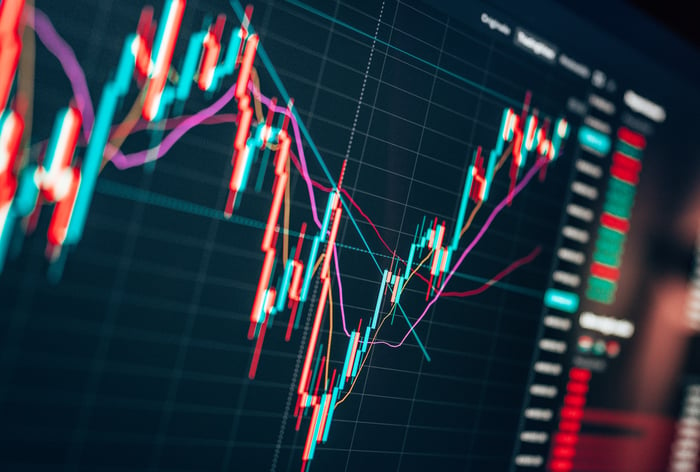Every so often, Wall Street sends investors a not-so-subtle reminder that stocks can go down just as easily as they can rise. Last year was a perfect example of this, with the Dow Jones Industrial Average, S&P 500, and Nasdaq Composite all dropping into bear markets and delivering their worst single-year returns since the financial crisis.
Thankfully, short-term pain begets opportunity for long-term investors. Even though we'll never know ahead of time how long a downturn in the stock market will last, we do know that every correction, crash, and bear market throughout history has eventually been placed into the back seat by a bull market. On Wall Street, patience really does pay.

Image source: Getty Images.
Bear markets can be a particularly good time to go shopping for beaten-down growth stocks that bring innovation and competitive advantages to the table. What follows are three high-octane growth stocks that have lost between 90% and 93% since hitting their all-time highs yet possess the catalysts necessary to double your money by 2026.
Teladoc Health: 92% below its all-time high
To be perfectly blunt, telemedicine stock Teladoc Health (TDOC -3.06%) was an absolute dumpster fire in 2022. Thanks to three separate goodwill writedowns tied to its (in hindsight) grossly overpriced $18.5 billion acquisition of applied health signals company Livongo Health, Teladoc lost $84.60 per share for the year. If these non-cash impairments are backed out, the company's full-year loss stood at a far less frightening $1.59/share.
The biggest catalyst moving forward for Teladoc Health is simple: no more massive writedowns. The company closed out 2022 with $1.07 billion left in goodwill on its balance sheet, which is a far more reasonable figure than the $14.5 billion it was lugging around when 2021 ended. With a considerably cleaner income statement expected this year, Teladoc can redirect investors' attention to the operating metrics that matter.
What makes Teladoc such an intriguing growth story, despite its mammoth miscue in overpaying for Livongo, is the way it's transforming the personal-care landscape. Virtual visits tend to be considerably more convenient for patients, and they can allow physicians to keep closer tabs on patients with chronic illnesses. Perhaps most important, the improvement in patient outcomes (especially for those with chronic conditions) should lead to lower expenses for health insurers. Anything that reduces expenses for insurers is something they're bound to promote.
For those of you thinking Teladoc was simply a fad stock that was in the right place at the right time during the COVID-19 pandemic, take a closer look at its revenue ramp in the six years prior to the pandemic. The company didn't average 74% annual sales growth between 2013 and 2019 by accident. This was a clear indication that virtual visits are positioned to change the personalized-care treatment landscape.
Although Livongo Health has been Teladoc's biggest eyesore, this applied health signals provider was a profitable company prior to being acquired. Of note, chronic-care membership continues to climb. As of Dec. 31, 2022, nearly 1.02 million people were enrolled, which is up 16% from the previous year. If Teladoc Health is able to successfully cross-sell its solutions, add new chronic-care members in 2023, and modestly reduce its operating expenses, a doubling in its share price by 2026 is perfectly feasible.
Bark: 93% below its all-time high
The second supercharged but downtrodden growth stock that has the tools and intangibles capable of doubling your money by 2026 is pet-focused products and services company Bark (BARK -1.82%).
Like most special purpose acquisition companies (SPACs), Bark has been put in the doghouse since its debut in late 2020. As interest rates rose and the bear market took hold, investors turned their attention to profitable businesses and punished those with recurring losses, like Bark. However, sustained weakness in Bark may soon give way to better days.
The first thing to note is that the pet industry is exceptionally recession-resistant. Based on historical data from the American Pet Products Association (APPA), it's been well over a quarter of a century since year-over-year U.S. pet expenditures declined. This means the dot-com bubble, financial crisis, and COVID-19 pandemic weren't enough to keep pet owners from opening their wallets ever wider for their furry, gilled, feathered, and scaled family members.
On a more company-specific basis, Bark stands out for its e-commerce focus. While it does have a presence in a number of big-box retailers, approximately 90% of Bark's sales derive from direct-to-consumer (DTC) subscriptions. A subscription-driven operating model tends to keep customer churn down and helps Bark wisely manage its inventory. By leaning on DTC sales, Bark should be able to maintain a gross margin of around 60%.
What's more, add-on sales are a big-time growth opportunity for Bark. During the pandemic, Bark introduced its Bark Bright service for dental products, Bark Home for basic accessories, and is rolling out Bark Eats, which is a dry-food diet catered to specific breeds. Add-on purchases are helping to lift average order value, which in turn is key to boosting gross margin and moving toward profitability.
But the most important data point from Bark's ill-received fiscal third-quarter report is that it generated $5.1 million in positive operating cash flow. With management taking cost reductions seriously, Bark is making real strides toward reaching recurring profitability by as soon as next calendar year.

Image source: Getty Images.
Fiverr International: 90% below its all-time high
The third high-octane growth stock that's been crushed, but has the ability to double your money by 2026, is gig economy up-and-comer Fiverr International (FVRR -4.11%). Once $336/share in February 2021, Fiverr has retraced all the way back to $34.
Arguably the biggest concern with Fiverr is that a variety of recession-probability indicators will prove accurate, and the U.S. enters a recession at some point this year. The U.S. unemployment rate usually rises during economic contractions, which wouldn't be a positive for an online-services marketplace that helps connect freelancers with businesses. But in the grand scheme of things, this worry is shortsighted.
Whereas the pandemic provided a temporary boost for a number of sectors and industries, it's led to a permanent shift in the workforce that favors Fiverr. Though some companies have requested workers come back to the office, more people are choosing to work remotely, either part-time or full-time, than ever before. That's a positive for Fiverr's online-services marketplace.
Fiverr has really stood out for its ability to continue growing both the number of buyers on its platform and its spending per buyer, despite a challenging economic environment. This success can be attributed to the company's transparent pricing model. While most competing platforms require freelancers to list their tasks on an hourly basis, Fiverr freelancers price their jobs on an all-inclusive basis. The proof is in the pudding (i.e., spend per buyer) that businesses favor the price transparency offered by Fiverr's platform.
However, the biggest advantage Fiverr offers its shareholders is its far-and-away superior take rate. The "take rate" describes the percentage of each deal on its platform that it gets to keep. Most competing online-service marketplaces have take-rates or around 15%, give or take a little bit. Meanwhile, Fiverr's take-rate hasn't stopped climbing and hit 30.2% in the fourth quarter. Having such a high take-rate without scaring off its freelancers or buyers all but ensures Fiverr's margins and profits will outpace its competition.
Lastly, Fiverr is the only recurringly profitable company of the three listed here. That gives it a solid chance of attracting fundamentally focused investors.





